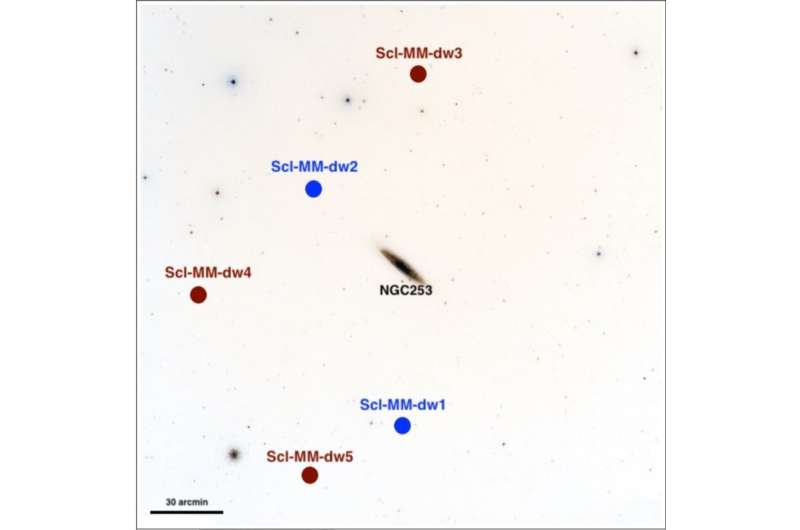August 31, 2021 report
Three new ultra-faint dwarf galaxies discovered

Using the Hubble Space Telescope (HST), astronomers have detected three new ultra-faint dwarf galaxies associated with the nearby spiral galaxy NGC 253. The newly found dwarfs turn out to be among the faintest systems so far discovered beyond the Local Group. The finding is reported in a paper published August 20 on arXiv.org.
The so-called ultra-faint dwarf galaxies (UFDs) are the least luminous, most dark matter dominated, and least chemically evolved galaxies known. Therefore, they are perceived by astronomers as the best candidate fossils from the universe at its early stages.
The Panoramic Imaging Survey of Centaurus and Sculptor (PISCeS) project is one of astronomical surveys aimed at finding new faint satellite galaxies, including UFDs. As part of PISCeS, a team of astronomers led by Burçin Mutlu-Pakdil of the University of Chicago has observed the field around NGC 253 with HST, searching for satellite dwarf systems. At a distance of some 11.4 million light years, NGC 253 is the principal galaxy of the nearby Sculptor group.
The team visually inspected all the images, searching for spatially compact overdensities of stars around NGC 253 and found three new UFDs—in addition to the two known ones identified in 2014 and 2016.
"In this work, we report the discovery of three ultra-faint dwarf satellite galaxies of NGC 253 in a visual search of the Magellan/Megacam images taken as part of PISCeS, our panoramic imaging campaign to find faint substructure within <100 kpc of NGC 253," the astronomers wrote in the paper.
The newfound UFDs received designations Scl-MM-dw3, Scl-MM-dw4 and Scl-MMdw5. They are uniformly old (estimated ages of about 12 billion years), with nearly all of their stars forming in the early universe, thus the astronomers consider them as pristine fossils from the era of reionization.
Scl-MM-dw3 is the smallest UFD out of the newly detected trio as its elliptical half-light radius along the semi-major axis was estimated to be about 362 light years. The galaxy is located some 11.34 million light years away from the Earth and approximately 264,000 light years away from NGC 253. Its stellar mass was calculated to be at a level of 110,000 solar masses.
Scl-MM-dw4 turns out to be as massive as Scl-MM-dw3, but is nearly 70 percent larger—its half-light radius was measured to be 613 light years. This UFD is located about 13.37 million light years away, and its distance to NGC 253 is estimated to be some 280,300 light years.
With a half-light radius of about 1,167 and a mass of some 140,000 solar masses, Scl-MM-dw5 is the largest and most massive dwarf out of the three new UFDs. The galaxy is located approximately 12.71 million light years away from the Earth and about 313,000 light years from NGC 253.
The astronomers underlined that the newfound dwarfs have luminosities between -7.5 and -7.24 mag, this places them among the faintest galaxies identified outside our Local Group.
More information: Burçin Mutlu-Pakdil et al, Hubble Space Telescope Observations of NGC 253 Dwarf Satellites: Discovery of Three Ultra-faint Dwarf Galaxies, arXiv:2108.09312 [astro-ph.GA] arxiv.org/abs/2108.09312
© 2021 Science X Network





















